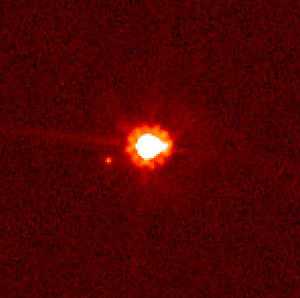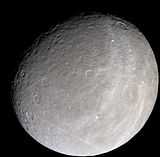Dysnomia (moon)
|
Dysnomia, to the left, and Eris, center (Hubble Space Telescope) | |
| Discovery | |
|---|---|
| Discovered by | Michael E. Brown, M. A. van Dam, A. H. Bouchez, D. Le Mignant, R. D. Campbell, J. C. Y. Chin, A. Conrad, S. K. Hartman, E. M. Johansson, R. E. Lafon, D. L. Rabinowitz, P. J. Stomski Jr., D. M. Summers, C. A. Trujillo, and P. L. Wizinowich[1] |
| Discovery date | September 10, 2005[1] |
| Designations | |
| MPC designation | (136199) Eris I Dysnomia |
| Pronunciation | /dɪsˈnoʊmiə/ or /daɪsˈnoʊmiə/[lower-alpha 1] |
| S/2005 (2003 UB313) 1 | |
| Adjectives | Dysnomian |
| Orbital characteristics[2] | |
| 37350±140 km | |
| Eccentricity | < 0.013 |
| 15.774±0.002 d | |
Average orbital speed | 0.172 km/s[lower-alpha 2] |
| Inclination | 142°±3° |
| Satellite of | Eris |
| Physical characteristics | |
Equatorial radius |
342±25 km (albedo five times lower than Eris's)[3] 175–245 km[4] 50–125 km[lower-alpha 3][5] |
| ~23.1[6] | |
| ~3.2[lower-alpha 4][4][6] | |
Dysnomia, officially (136199) Eris I Dysnomia (Greek: Δυσνομία), is the only known moon of the dwarf planet Eris (the most massive known dwarf planet in the Solar System). It was discovered in 2005 by Mike Brown and the laser guide star adaptive optics team at the W. M. Keck Observatory, and carried the provisional designation of S/2005 (2003 UB313) 1 until officially named Dysnomia[7] (from the Ancient Greek word Δυσνομία meaning "lawlessness") after the daughter of the Greek goddess Eris.
Discovery
During 2005, the adaptive optics team at the Keck telescopes in Hawaii carried out observations of the four brightest Kuiper belt objects (Pluto, Makemake, Haumea, and Eris), using the newly commissioned laser guide star adaptive optics system. Observations taken on 10 September revealed a moon in orbit around Eris, provisionally designated S/2005 (2003 UB313) 1. In keeping with the Xena nickname that was already in use for Eris, the moon was nicknamed "Gabrielle" by its discoverers, after Xena's sidekick.[8][9]
Properties
Dysnomia was found 4.43 magnitudes fainter than Eris,[4][6] and its diameter is estimated to be between 350 and 490 km,[4] though Mike Brown claims that it is 500 times fainter and between 100 and 250 km in diameter.[5] It is 60 times fainter than Eris in the K band and 480 times fainter in the V band, which means a very different, and quite redder, spectrum, indicating a significantly darker surface.[10] Assuming its albedo is five times lower than Eris's, its diameter would be 685±50 km.[3]
Combining Keck and Hubble observations, the satellite was used to determine the mass of Eris, and orbital parameters were estimated. Its orbital period is calculated to be 15.774±0.002 d.[2] These observations indicate that Dysnomia has a circular orbit around Eris, with a radius of 37350±140 km.[2] This shows that the mass of Eris is 1.27 times that of Pluto.[2]
Formation
Astronomers now know that three of the four brightest Kuiper belt objects (KBOs) have satellites. Among the fainter members of the belt only about 10% are known to have satellites. This is believed to imply that collisions between large KBOs have been frequent in the past. Impacts between bodies of the order of 1000 km across would throw off large amounts of material that would coalesce into a moon. A similar mechanism is believed to have led to the formation of the Moon when Earth was struck by a giant impactor early in the history of the Solar System.
Name
Mike Brown, the moon's discoverer, chose the name Dysnomia (Greek: Δυσνομία) due to a number of associations it had for him. Dysnomia, the daughter of Eris, fits the general historically established pattern of naming moons after lesser gods associated with the primary (hence, Jupiter's largest moons are named after lovers of Jupiter, while Saturn's are named after his fellow Titans). Also, the English translation of "Dysnomia", "lawlessness", echoes Lucy Lawless, the actress famous for starring in Xena: Warrior Princess on television. Before receiving their official names, Eris and Dysnomia were known informally as "Xena" and "Gabrielle", and Brown decided to retain that connection.
Brown also notes that Pluto owes its name in part to its first two letters, which form the initials of Percival Lowell, the founder of the observatory where its discoverer, Clyde Tombaugh, was working, and the person who inspired the search for "Planet X". James Christy, who discovered Charon, followed the principle established with Pluto by choosing a name which shared its first four letters with his wife's name, Charlene. "Dysnomia", similarly, has the same first letter as Brown's wife, Diane,[11] and Brown uses the nickname "Dy" /ˈdaɪ/ for the moon, which he pronounces the same as his wife's nickname, Di. Because of this, Brown pronounces the full name /daɪsˈnoʊmiə/, with a long "y".[12]
In addition, both Eris and Dysnomia, representing aspects of chaos, reflect the effect their existence had in the disputation on the definition of a planet (and specifically on the status of Pluto and Ceres), and the debate that followed.
Notes
- ↑ dis-NOH-mee-ə or dys-NOH-mee-ə. The first is the normal mythological pronunciation, the latter is used by Brown.
- ↑ The orbital period (P) is 15.774 d. The orbital circumference (C) is 2π*semi-major axis. Dividing these (P/C) using the correct units gives 0.172 km/s.
- ↑ According to Michael E. Brown, it is 500 times fainter.
- ↑ Dysnomia was found 4.43±0.05 mag fainter than Eris. With H = −1.19 for Eris, this gives H ≈ 3.2 for Dysnomia.
References
- ↑ 1.0 1.1 Brown, M. E. et al. (2006). "Satellites of the Largest Kuiper Belt Objects" (PDF). Astrophysical Journal Letters 639 (1): L43. arXiv:astro-ph/0510029. Bibcode:2006ApJ...639L..43B. doi:10.1086/501524. Retrieved 2011-10-19.
- ↑ 2.0 2.1 2.2 2.3 Brown, M. E.; Schaller, E. L. (2007). "The Mass of Dwarf Planet Eris". Science 316 (5831): 1585. Bibcode:2007Sci...316.1585B. doi:10.1126/science.1139415. PMID 17569855.
- ↑ 3.0 3.1 Santos-Sanz, P. et al. (2012). ""TNOs are Cool": A Survey of the Transneptunian Region IV. Size/albedo characterization of 15 scattered disk and detached objects observed with Herschel Space Observatory-PACS". arXiv:1202.1481 [astro-ph.EP].
- ↑ 4.0 4.1 4.2 4.3 Johnston, W. R. (30 December 2008). "(136199) Eris and Dysnomia". Johnston's Archive. Retrieved 2012-04-12.
- ↑ 5.0 5.1 Brown, M. E. (14 June 2007). "Dysnomia, the moon of Eris". Caltech. Retrieved 2011-07-03.
- ↑ 6.0 6.1 6.2 Green, D. W. E. (4 October 2005). "S/2005 (2003 UB313) 1". IAU Circular 8610. Retrieved 12 January 2012.
- ↑ Green, D. W. E. (13 September 2006). "(134340) Pluto, (136199) Eris, and (136199) Eris I (Dysnomia)". IAU Circular 8747. Retrieved 12 January 2012.
- ↑ Zabarenko, D. (3 October 2005). "Planet Xena has moon called Gabrielle". Australian Broadcasting Corporation. Retrieved 9 March 2008.
- ↑ Ingham, R. (2 February 2006). "'Tenth planet' Xena bigger than Pluto". Australian Broadcasting Corporation. Retrieved 9 March 2008.
- ↑ Sicardy, B. et al. (2011). "A Pluto-like radius and a high albedo for the dwarf planet Eris from an occultation" (PDF). Nature 478 (7370): 493–496. Bibcode:2011Natur.478..493S. doi:10.1038/nature10550. PMID 22031441.
- ↑ Tytell, D. (14 September 2006). "All Hail Eris and Dysnomia". Sky & Telescope. Retrieved 30 December 2006.
- ↑ "Julia Sweeney and Michael E. Brown". Hammer Conversations: KCET podcast. 2007. 42 min 12 sec. Retrieved 28 June 2008.
External links
![]() Media related to Dysnomia at Wikimedia Commons
Media related to Dysnomia at Wikimedia Commons
| ||||||||||||||||||||
| |||||||||||||||||||||||||||
| ||||||||||||||
| ||||||||||||||
| ||||||||||||||
| ||||||||||||||||||||||||||||||||||||||||||||||||

